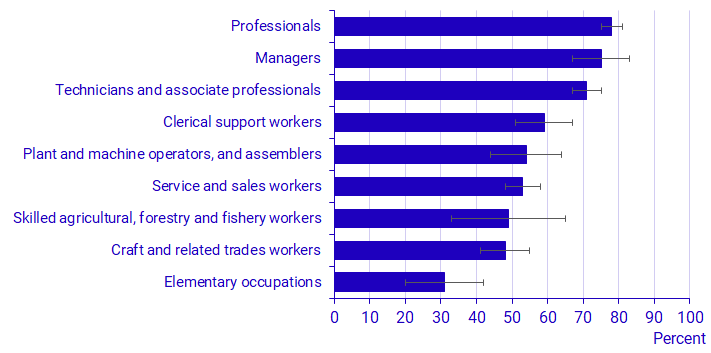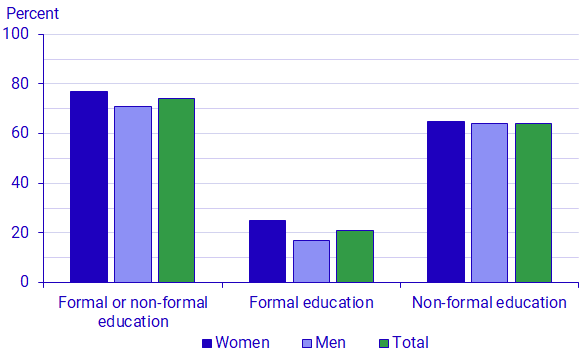Adult education survey 2022
Remote education for employees has increased significantly
Statistical news from Statistics Sweden 2023-12-06 8.00
The rapid technological advancement and the coronavirus pandemic have contributed to an increased pace of adaptation and a higher demand for digital solutions in conducting education. This can be noted in all education but particularly within employer sponsored education and training. From 2016 to 2022, the proportion of remote employer sponsored education and training has increased from 5 to 35 per cent.
The availability of skilled personnel is essential for companies to develop and grow. Most Swedish companies therefore offer their employees education and training during working hours. Within the approximately 4.3 million employed persons aged 25-64 years, 64 per cent participated in some form of education within a year’s time. The largest proportion takes place in non-formal education, which is organised education that takes place outside the regular education system. A smaller percentage takes place in formal education, i.e., within the regular education system.
"The proportion of employees participating in employer sponsored education and training has maintained between 60 and 70 per cent since 2012. Remote education has been established for a long time and is relatively common in the regular education system. However, the proportion of remote education for employees has only represented 5 percent of all employers sponsored education and training in both 2012 and 2016. The digitisation and the coronavirus pandemic have fuelled the implementation of more and better digital solutions in general, and distance learning has gained momentum in employer sponsored education and training” says Mattias Fritz, analyst at Statistics Sweden.
Most employer sponsored training among managers and employees with higher education qualifications
People in occupations requiring higher education qualifications, advanced higher education qualifications or executive positions were the most likely to participate in employer sponsored education and training. Among people in these groups, the participation rate was over 70 per cent. Employer sponsored education and training is least common in occupations in agriculture, horticulture, forestry and fishing, in construction and manufacturing, and in elementary occupations requiring only a short course or introduction.
Employed and self-employed as main occupation aged 25-64 years
Three out of four participate in education and training
Over a 12-month period, 74 per cent of the adult population aged 25-64 participated in education and training. This refers to all types of education and training, formal and non-formal, as well as both employers sponsored education and training and leisure education. Participation differs slightly between genders. Women participate to a slightly greater extent in formal education than men, 25 per cent and 17 per cent respectively. This is related to the fact that a higher proportion of women than men study in municipal adult education and first-cycle tertiary programmes.
Population aged 25-64 years
Education in leisure time partly reflects working life
Among people aged 25-64, 17 per cent have undertaken at least one educational activity in their leisure time in the last 12 months. The most common reason for this is to increase knowledge in a specific subject.
Education that takes place in leisure time is education that is not paid for by the employer, is not conducted during paid working hours and is not part of the regular education system. The classification of an activity as a leisure activity does not mean that it was necessarily related to leisure interests. Approximately one in five non-formal education activities in leisure time were mainly work-related and the proportion was higher among people with below upper secondary education and unemployed people.
"Leisure-time education provides people with opportunities for personal development and self-realisation, but it also contributes to reducing social inequalities and helps us to keep up with the ever-changing world of knowledge and technology” explains Mattias Fritz.
Publication
Read more in the report Adult education survey 2022.
Feel free to use the facts from this statistical news but remember to state Source: Statistics Sweden.
